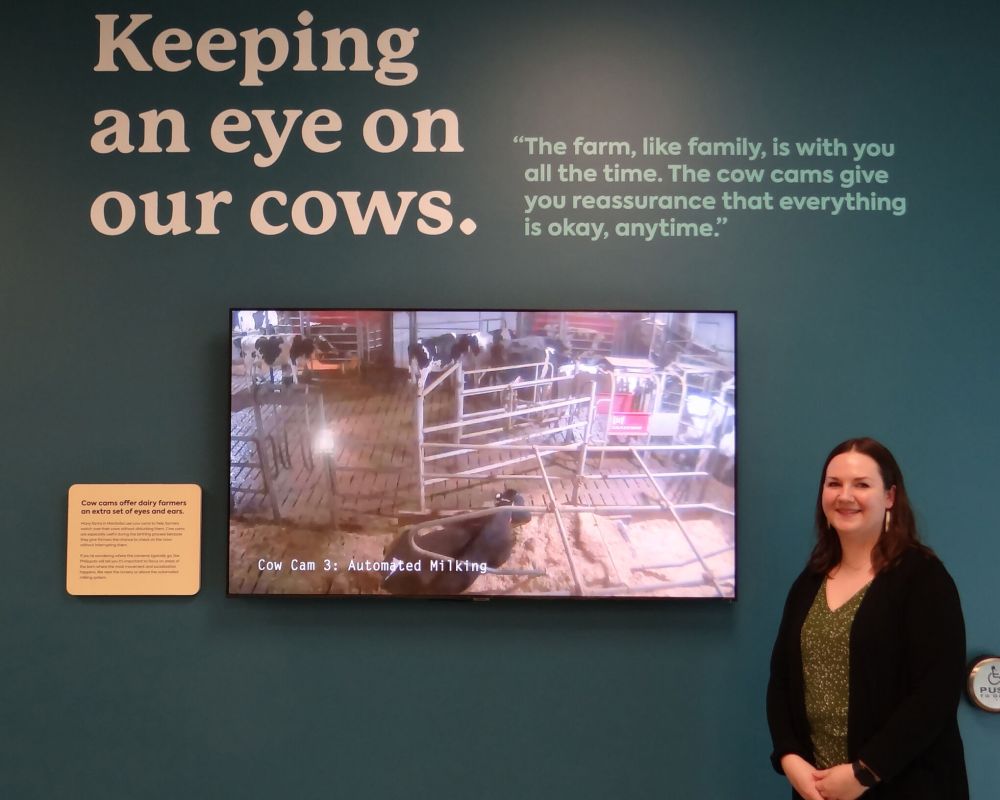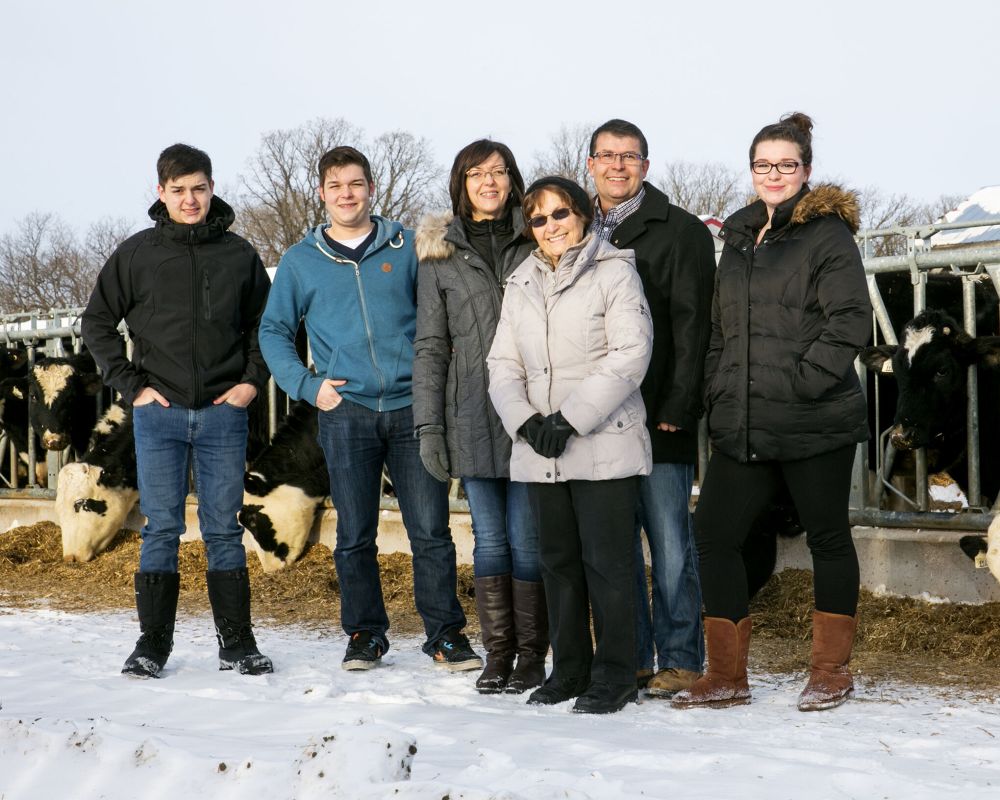Got milk? Glenlea dairy exhibit covers all the bases
Advertisement
Hey there, time traveller!
This article was published 14/04/2022 (1216 days ago), so information in it may no longer be current.
For anyone who has ever wondered why a cow needs four stomachs instead of one, a visit to the Manitoba Dairy Farmers Discovery and Learning Complex at the Glenlea Research Station is certainly in order.
A life-size cut-out of a cow with four flip-up panels that uncover an explanation of the role each of the stomachs plays in the digestive process, is just one of a host of innovative and interactive displays in the newly renovated exhibition area next to the dairy barn.
Since it opened in 2018, the new Glenlea dairy barn has been a popular public education component for visitors to the Bruce D. Campbell Farm and Food Discovery Centre.

The Manitoba Dairy Farmers exhibition centre further enhances teaching and outreach, through a rare opportunity to engage with modern dairy production, without having to visit a milk producer’s farm.
Hands-on displays show the latest in technology, featuring both video presentations and interactive displays. Visitors step on a pair of footprints on a floor-pad to activate a video showing and explaining why cows are given foot baths. At another display, one of three miniature cows in slots is pushed forward in an attempt to choose which is the right one in a “pick-a-cow-ready-to-milk” video game. Another display allows the controlling of lights and fans, demonstrating the value of computerized environmental controls in modern dairy barns. At another, a touch of the button, allows visitors to watch the compete manure recycling process, from cow to crops. And those are just a few of the many, which visitors can spend hours enjoying during a visit to the centre.
While displays and exhibits already occupy most of the wall space and floor space at the centre, there is a plan for all the available space and the few empty areas are already spoken for.
The remaining space in the large display area, with windows overlooking the dairy barn, will be taken up by a kitchen area on one side and a large video screen will be used for meetings or tours in the space at the other corner.
Eventually, the screen and that area of tables and chairs will be used as part of a University of Manitoba program. Students doing labs in the barn will have classroom space in the same building.
The kitchen will have a fridge and dishwasher for field trip snacks. Young students get to make ice-cream balls using cream, sugar, vanilla and ice. It is interactive activities like this, which visitors can enjoy, that are a very important part of the new dairy learning centre.
Farm and Food Discovery manager Kristen Matywchuk says the The Dairy Farmers of Manitoba Discovery and Learning Complex focuses on family, as dairy is largely family-based and generational.
That “Manitoba Dairy…Generations in the Making” theme is well-represented on a wall featuring the Philippot family of St Claude.

The Philippot family story is featured in a book created by the Dairy Farmers of Canada, showcasing the contributions of dairy farmers in the building and growth of dairy across Canada over the past 150 years.
The book traces the emergence of dairy farming in each of Canada’s provinces through the personal stories of a family which has been farming for many generations. The Philippot’s story is the Manitoba farm featured.
It is that story that has been capsulized and put on display on the feature wall at the Dairy Farmers of Manitoba Discovery and Learning Complex.
A time-line chart takes visitors through three generations of Philippots on the family farm at St Claude for more than 100 years, recounting numerous highlights, both family and dairy industry.
The Philippot story reflects the challenges, innovations, growth and success of the dairy industry in Manitoba over three generations.
Alexis Philippot, who arrived in Manitoba from France, and his wife Marie bought land and began dairy farming in 1917, when cows were milked by hand. In the 1930’s, when next to nothing would grow, Philippot found his cows thrived on native grasses, which grew like weeds and with a new barn, built before the Depression, was able to expand the dairy.
The second generation, the Raymond and Laurette Philippot family, enjoyed the luxury of the introduction of electric milking machines and other labour-saving devices like the mechanical barn-cleaner.

Today’s third generation, the Alain and Michelle Philippot family, see their cows milked by robots and a “cow-cam” makes sure everything is going well in the barn.
When Alain took over the farm in 1991, he was able to double milk production, thanks to a new water filtration system, which had been installed a year earlier. Since last year, when an automated milking system was installed, cows can now walk in to be milked at any time of the day.
That is just the latest, but very likely not the final innovation, or the final generation of Philippots, to be seen at this century-old family farm.
The Philippot farm is deeply rooted in family tradition, and Alain and Michelle are looking forward to passing it on to their children, because they know it will be in good hands.
The final panel of the Philippot wall display acknowledges that the farm is located on Treaty 1 land and reflects the third generation dairy farmer’s feelings about the land.
“We would like to continue farming while honouring the spirit and intent of Treaty 1 and the original stewards of the land. We commit to doing the best we can as farmers and Treaty 1 beneficiaries while caring for this land.”
The feature wall and displays at the Dairy Farmers of Manitoba Discovery and Learning Centre represents the history and progress of dairy in Manitoba very well.

Being able to look through the walls of windows in the viewing area to watch a modern dairy barn in action is an added bonus.
The 60-cow facility features robotic milking and feeding systems, free stalls for dairy cattle, dedicated spaces for calves, milk collection tanks, above-ground manure storage and related laboratory equipment.
Researchers are able to individually manage multiple groups of animals in a free-stall setting, enabling intensive studies of nutrient intake, microbial diversity and infectious diseases, without needing to move the animals off-site.
And while in-person tours will give visitors an opportunity to see first-hand the new displays, and watch cows being cows, the virtual tours, which were introduced during COVID restrictions, will still be very much a part of the program, especially for distant schools, which cannot realistically make the field trip to the the Discovery Centre, Kristen says.
